Intermittent fasting has taken the wellness world by storm in recent years, becoming one of the most popular health trends for its touted health benefits. Part of its popularity stems from the fact that, unlike traditional diets, intermittent fasting plans only restrict when you eat, not what you eat. Many health experts do recommend following a low-carb diet if you plan to intermittent fast, but there are no actual food restrictions. The benefits? By giving your body more time between meals, you give your digestive system a chance to reboot and reset, while also balancing blood sugar levels and improving symptoms of common digestive disorders.
With so many different ways to intermittent fast, it’s pretty easy to make this age-old practice work for you, your lifestyle and your goals. Whether you’re new to fasting or just looking to learn more about it, our guide will help you make the best decisions for your body and kickstart your journey to health.
Intermittent Fasting 101
The idea of fasting has been around for centuries, as food wasn’t always readily available like it is now. Fasting is also used in various religions and spiritual practices to start a purification process in the body or solidify one’s commitment to a higher power.
Intermittent fasting works by consolidating your eating window and only eating for a certain time period during the day. While the most common fasts are a 12 or 16 hours long, there are a variety of different schedules to choose from depending on your health history and goals. Through the process of intermittent fasting, not only does your body regulate your insulin levels, but it also undergoes vital cellular repair, experiences beneficial changes to genes, and has elevated levels of human growth hormone (this is a good thing!)
Benefits of Fasting
The benefits behind intermittent fasting happen at a cellular and molecular level. And while fasting is no longer a necessity in the modern world, the human body has actually evolved over the centuries to be able to abstain from food for long periods of time. After 8 hours of fasting, your body uses up its glucose reserves and begins to dip into stored fat for energy, leading to weight loss and an increase in metabolic function.
Fasting gives your body a break from the process of digestion, so your cells and genes are able to focus on repairing themselves. This leads to a variety of health benefits for both your body and brain, including:
- Extend your lifespan and quality of life. The gene repair that takes place when abstaining from food helps to prevent disease.
- Those suffering from type 2 diabetes see a drop in insulin levels when fasting. Studies have even shown that fasting improves glucose levels and insulin resistance.
- Your brain performs better and is healthier. Fasting has been proven to increase levels of the brain-derived neurotrophic factor (BDNF), a hormone that is vital to the creation of new cells and the overall health of your brain.
- An increase in mental clarity, focus, and overall alertness have been reported in those who intermittent fast.
- Easier to lose weight and maintain that weight loss over time because you are restricting when you eat rather than what you eat.
However, it’s important to note that there are some drawbacks to intermittent fasting including hunger, irritability, nausea, and inability to meet nutrient needs. It’s important to talk to your doctor and carefully consider your health history, eating habits, and body type when deciding what fasting schedule to follow, as some are not suitable for everyone.
Intermittent Fasting Schedules
There are lots of different options when it comes to how you can intermittent fast. Keep in mind that intermittent fasting isn’t for everyone, and it’s best suited to those who are already following a low-carb way of eating. Fasting does not take the place of a balanced, nutrient-dense diet, but it can be a great complement if you find a method that works for you.
We’re breaking down some of the different options when it comes to intermittent fasting, including sample eating windows and the pros and cons of each.
12:12 Fasting Schedule
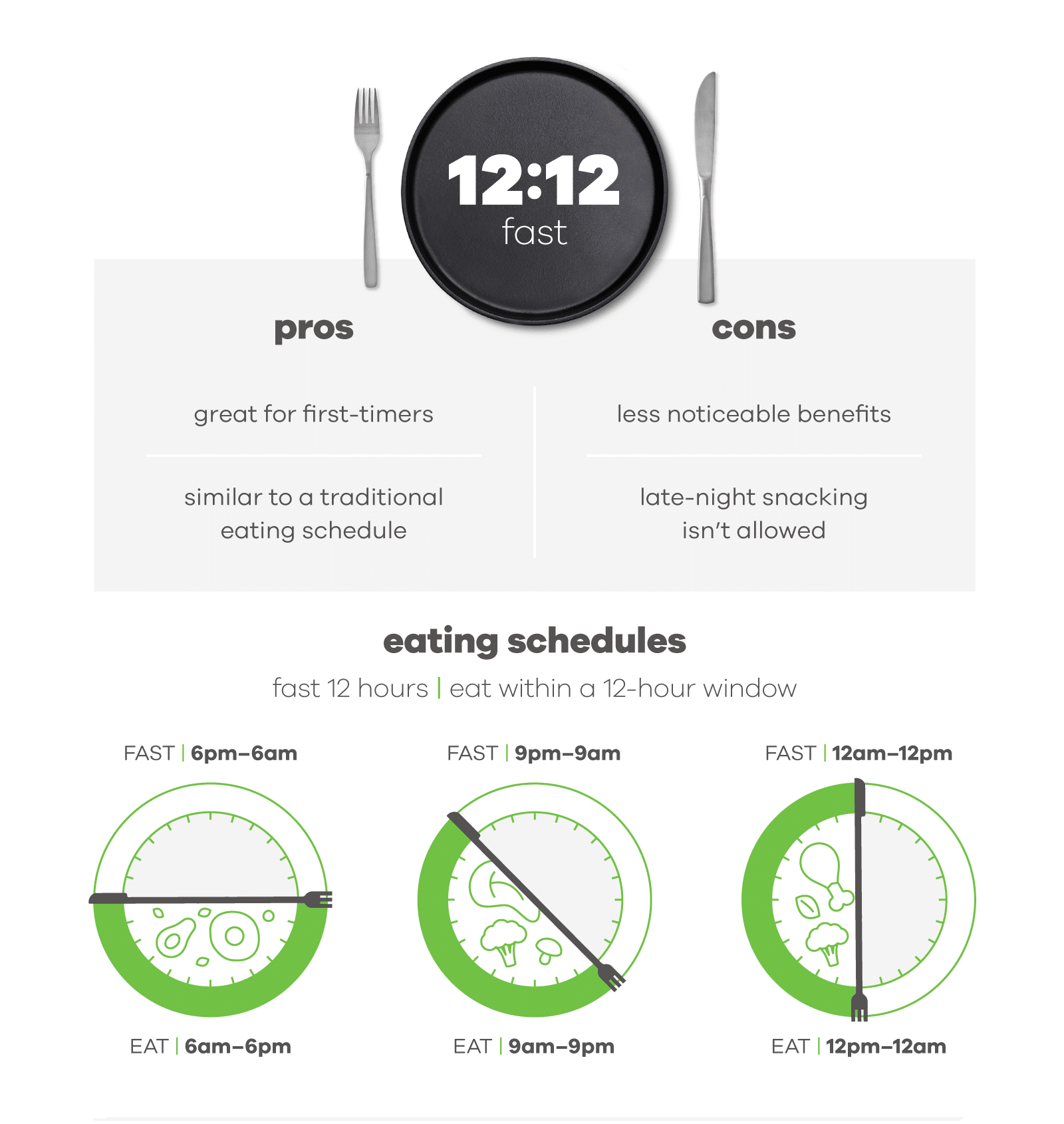
While the 12:12 intermittent fasting method isn’t the most popular, it’s the best option for the average person. The shorter fasting window is easier to attain and safer for those who might not fare well with a longer fast. It’s also a great way to experiment with fasting to see if it works for you. The main downside is that you likely won’t see the dramatic impact, including mental clarity and cellular and gastrointestinal repair, that a longer fast might offer.
This is a great option to start with, to evaluate whether fasting works for you and to avoid shocking your body. If you currently go less than 12 hours between dinner and breakfast, you can start by slowly extending that window in 30-minute increments until you achieve the 12-hour window. Some examples of eating schedules include eating from 8 am to 8 pm or from 12 pm to 12 am each day, fasting for the remaining hours.
16:8 Fasting Schedule
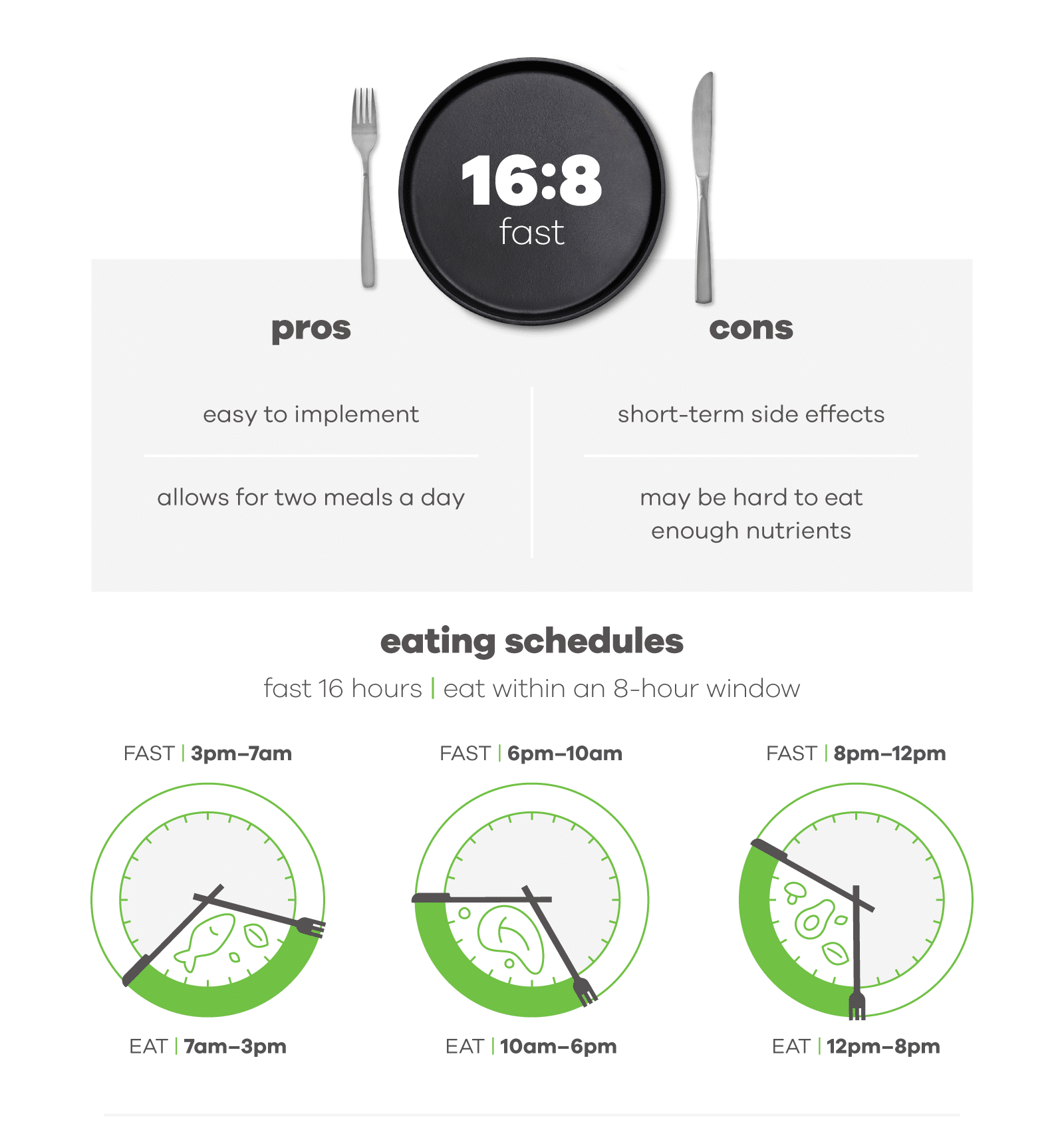
One of the most common intermittent fasting schedules, 16:8, requires 16 hours of fasting at a time with an 8-hour eating window. This method is most often taken on as a daily practice, but can also be used a few times a week depending on your personal preferences. 16 hours of fasting allows your body to burn more fat, regulate insulin levels and improve brain function, making it a great option if you’ve already mastered the 12:12 fast and you’re eating a low carb diet (<100g of carbs/day). If you’re eating a standard American diet with a higher amount of carbs, intermittent fasting ends up being more of a stressor to your body than a benefit.
The most common side effect of the 16:8 fasting schedule happens during the first week. As the body transitions to its new eating schedule, you may have intense feelings of hunger and some irritability. You will mostly avoid these symptoms if you eat low carb to begin with since your insulin and hormones will already be fairly well regulated. Rest assured that these side effects are totally normal and tend to go away within a few weeks (as your body is great at adapting quickly to fasting patterns)! Those who adhere to the 16:8 schedule typically eat from 10 am to 6 pm or from 12 pm to 8 pm.
20:4 Fasting Schedule
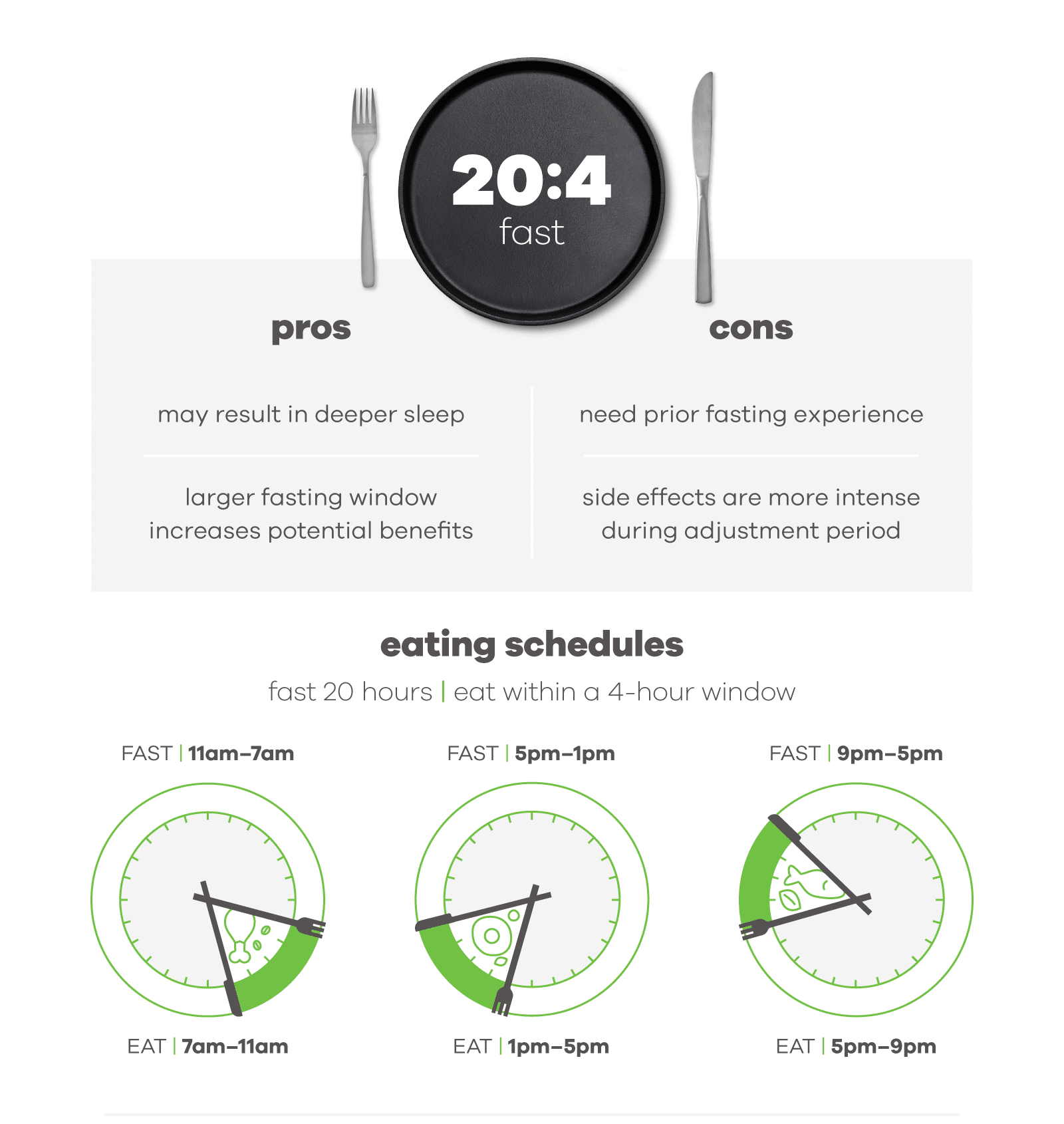
Also called the Warrior Diet, coined in 2002 by Israeli Special Forces member Ori Hofmekler, this diet is based on the practices of Roman soldiers looking to increase stamina and strength. The idea is that by fasting, or only eating pre-approved low-calorie foods, for 20 hours and then eating high-calorie foods for 4, your body is able to repair itself for a longer period of time. This is an extreme method of intermittent fasting and not one that’s recommended for most people.
Not only is the 20:4 fasting schedule difficult and therefore not recommended for beginners, but it also may put undue stress on your body unless you’re following a very low carb (ketogenic) diet to begin with. Additionally, the majority of people cannot consume enough calories to sustain them in a four-hour window without drastically overeating their main meal, or continually eating for all four hours. If you’re interested in giving this form of fasting a go, it’s broken up into three phases:
- Phase 1, or the detox phase, is when a small amount of pre-approved foods are allowed throughout those 20 hours.
- Phase 2 focuses on high-fat foods during the 4-hour eating window.
- Phase 3 depicts an alternating eating schedule of high-carb and low-carb, high-protein meals during the 4-hour eating window.
Full-Day Fast (24H)
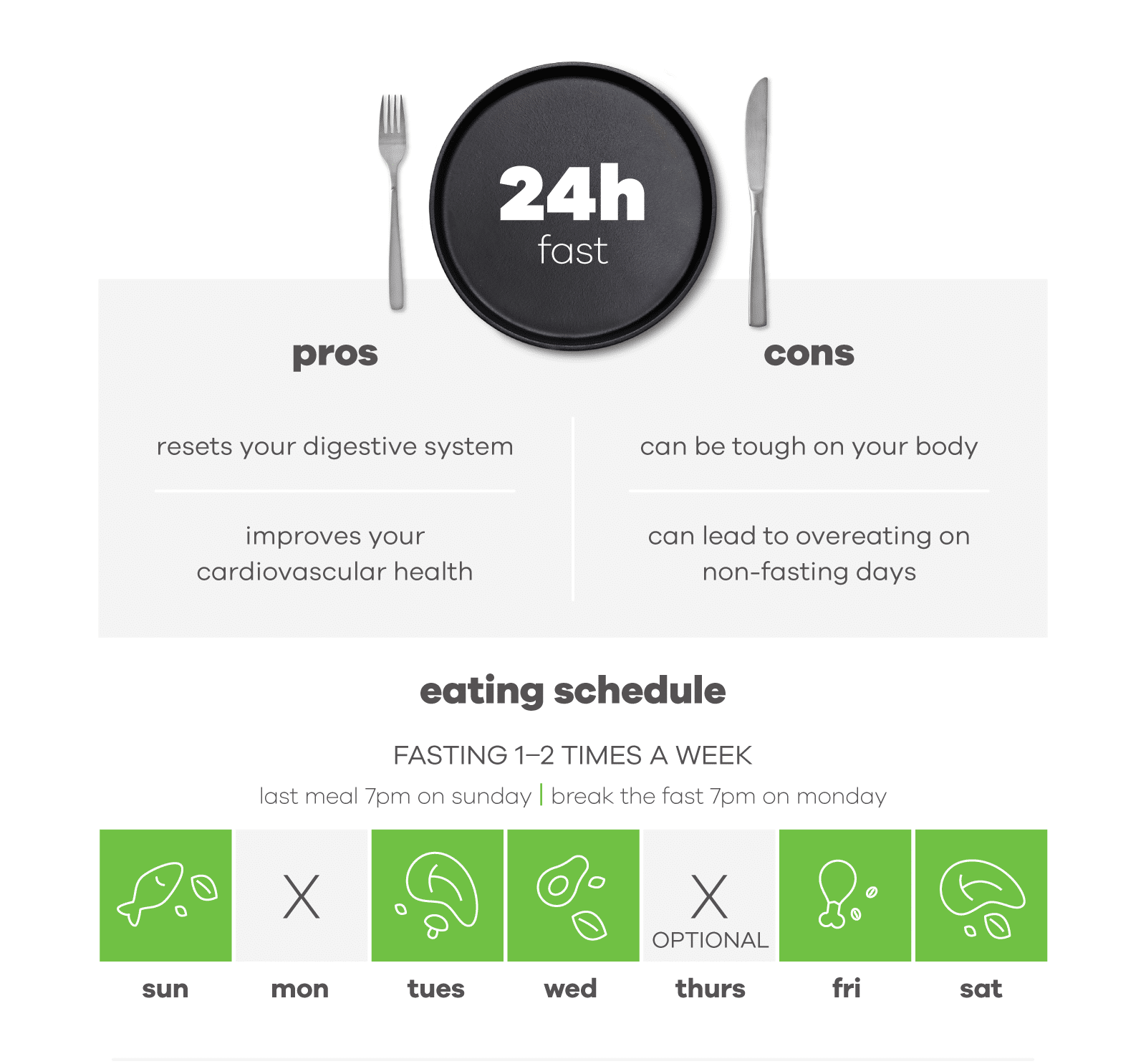
Fasting for a 24-hour period can have major benefits, like helping to reset gut bacteria and improving cardiovascular health. However, it should only be taken on by those with plenty of fasting experience or those whose doctors have recommended this fasting option.
A 24-hour fast shouldn’t be done more than two times a week and involves resuming normal eating habits on non-fasting days. This method is made slightly easier thanks to the fact that you can eat one meal each day. For example, eating dinner at 7 pm one day and at 7 pm the next day.
Three Day Fast (72H)
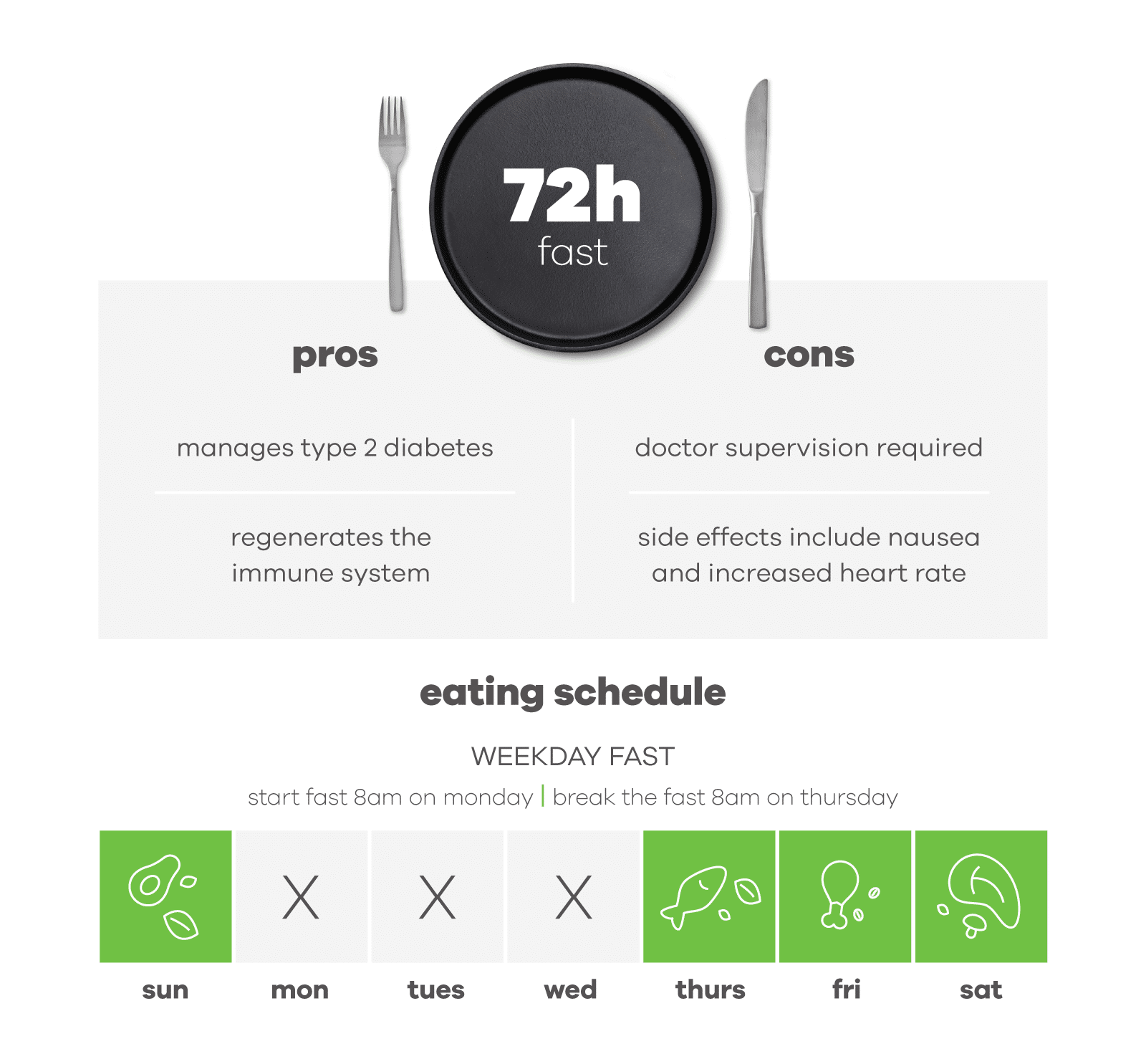
While there are researched benefits to this method, only drinking water for 3 whole days can be dangerous if not performed correctly and supervised by a physician who knows your health history.
When completed properly, 72-hour fasts provide a large list of health benefits and are sometimes recommended by doctors if you are trying to manage your type 2 diabetes. This method also accelerates cell turnover (known as autophagy), which involves the body clearing out damaged cells to make way for new, healthy cells. An example schedule for this plan is a weekend fast where you eat your last meal on Friday night and fast until Monday night.
When done properly, intermittent fasting can be a great tool for improving and maintaining health. The key is to make sure you’re doing a fasting method that works for you and listening to your body. If you’re new to fasting, make sure you start slow and slowly increase the number of hours your fasting, allowing your body time to adjust. It’s recommended to follow a low-carb diet on your non-fasting days to ease the stress that fasting can put on your body.
Not sure what to eat when you’re not fasting, or where to start when it comes to eating nutrient-dense meals? Get healthy, pre-cooked meals delivered straight to your door with our meal plans, so that no matter how you choose to fast, you can break your fast in a nutritious and convenient way.
Sources: Medical News Today | Healthline
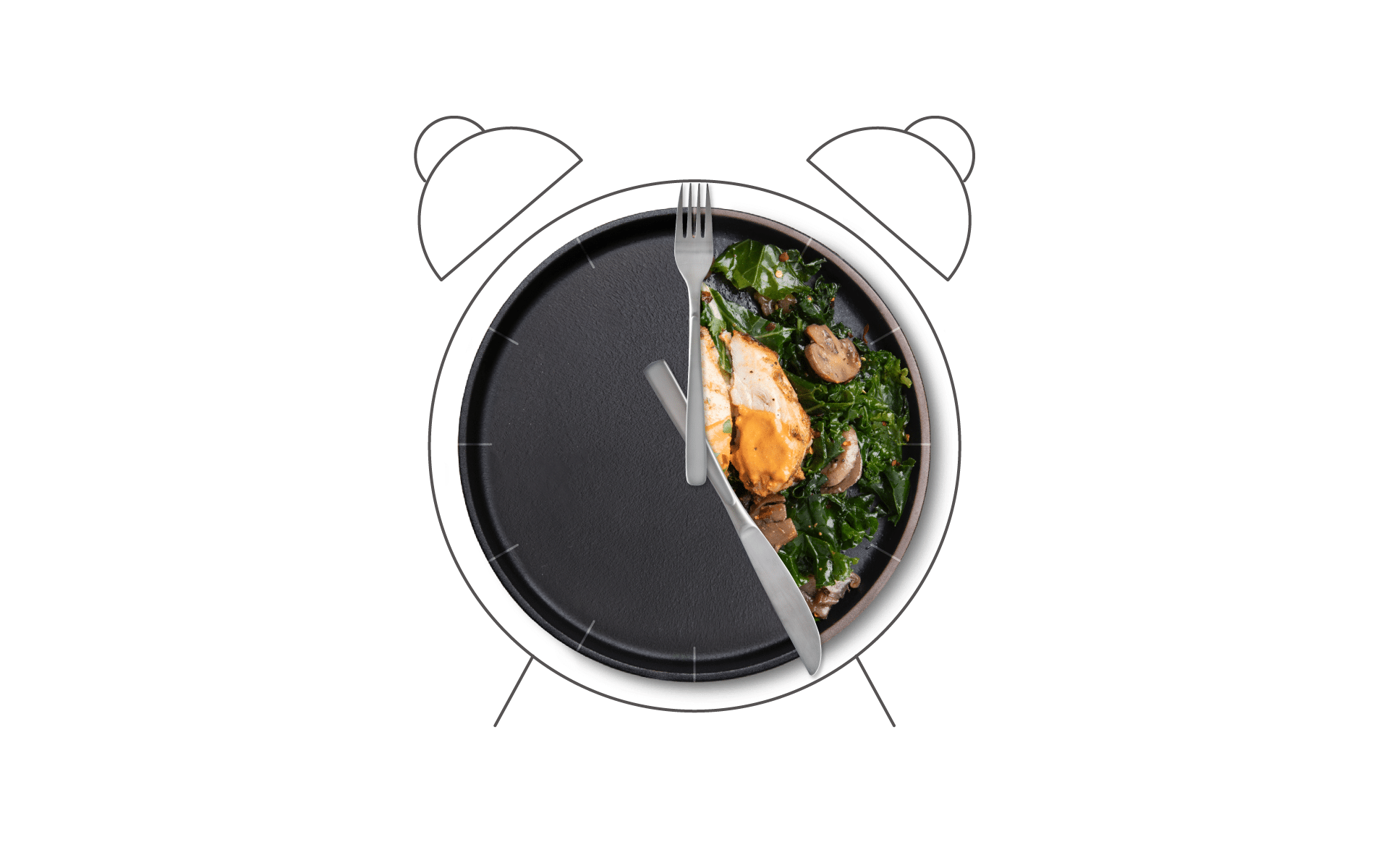





Leave a Reply
1 Comment
wonderful, thank you